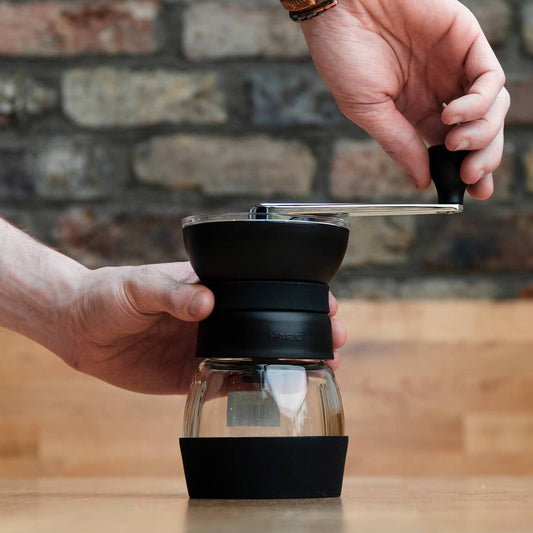Coffee is more than just a drink—it’s an experience, a ritual, and for many, a passion. However, improper storage can ruin even the finest beans' rich flavours and aromas.
In this blog, we’ll explore why coffee loses its flavour, the worst storage mistakes, and how to keep it fresh for the perfect cup every time. Plus, we will uncover how to recognize stale coffee before it’s too late.
Why does coffee lose its flavour?
Coffee’s incredible taste and aroma is the result of thousands of volatile compounds, natural oils, and organic molecules that interact to create aroma and taste. These components are highly sensitive to environmental factors. If coffee isn’t stored properly, these elements break down, diminishing the richness of your brew.
Here’s why coffee goes stale:
1. Oxidation: the silent flavour killer
The moment coffee is roasted, a natural process called oxidation begins. Oxygen interacts with the organic molecules in coffee, breaking down the oils and delicate compounds responsible for its vibrant flavours leading to a flat, lifeless taste.
- Ground coffee oxidizes faster than whole beans due to increased surface area exposure.
- Oxygen accelerates staleness— this is why vacuum-sealed containers like the Fellow Atmos Canister help extend freshness.
2. Degassing: the carbon dioxide factor
Freshly roasted coffee contains carbon dioxide gas, which slowly escapes over time. If this gas dissipates too quickly (due to poor storage), the coffee’s aroma and flavour degrade. Proper storage ensures that this degassing process doesn’t impact flavour retention.
3. Moisture exposure: a brewing disaster
Coffee is hygroscopic, meaning it absorbs moisture from the surrounding environment. When beans or grounds come into contact with humidity:
- Flavour dilution occurs, making the coffee taste dull.
- Mold and bacteria can form, rendering it unsafe to drink.
4. Heat: a hidden cause of staleness
Excessive heat speeds up the breakdown of coffee’s natural oils. If coffee is stored near a stove, oven or direct sunlight, its freshness deteriorates rapidly.
5. Light exposure: the invisible threat
Light—especially direct sunlight—breaks down delicate oils and aromatic compounds in coffee, stripping it of flavour and creating stale, muted notes.
To avoid light exposure, always store coffee in opaque, airtight containers rather than transparent jars.
6. Temperature changes
Constant temperature shifts—like those near kitchen appliances—cause coffee to expand and contract, damaging the molecular structure of its oils. Avoid storing coffee near refrigerators or heat sources to prevent premature aging.
Where not to store coffee
Even if you buy premium coffee beans, storing them in the wrong place will ruin freshness before you can even enjoy your cup.
Avoid these common mistakes:
1. On top of the kitchen sink
Moisture from steam and water evaporation makes this a risky spot. Over time, your beans will absorb humidity, leading to flavour loss and potential mold growth.
2. Next to the stove
Heat from cooking expands and contracts coffee’s oils unpredictably, accelerating its aging process and destroying delicate flavours.
3. In the refrigerator
One of the biggest myths about coffee storage is refrigerating beans to keep them fresh.
The truth? Coffee absorbs odors easily, and refrigerators contain a mix of foods that can alter its taste.
Additionally, temperature shifts cause condensation inside the bag or container, increasing moisture exposure.
Containers to avoid
Not all storage containers are suitable for keeping coffee fresh.
Some common mistakes include:
Plastic containers: they absorb odors and fail to provide a proper seal.
Glass jars: allow light exposure, reducing coffee quality over time
Paper or cardboard bags: they lack airtight seals, allowing oxygen and humidity to creep in.
The best storage solution: Fellow Atmos Canister
The Fellow Atmos Canister is designed to protect coffee from oxidation, light, and moisture using a twist mechanism that removes air from the container.
Why it works:
Vacuum-sealed technology: removes oxygen for longer-lasting freshness
Opaque body: prevents light exposure
Moisture-proof: keeps humidity away

For coffee lovers who value bold, aromatic, and freshness beans, this is the ideal storage choice.
Tips to preserve coffee flavour for longer:
1. Store in a cool, dark place
Instead of refrigerating or leaving coffee in bright light, store it in a pantry or sealed cabinet away from heat sources.
2. Buy whole beans instead of pre-ground coffee
Pre-ground coffee loses its freshness much faster than whole beans. Grind your coffee right before brewing to keep its full flavour intact.
3. Use the right grinder: Comandante C40 MK4
For precise grinding and optimal extraction, the Comandante C40 MK4 grinder is an excellent choice. Grinding small batches ensures every brew is fresh and flavourful.
4. Avoid overbuying coffee
While it’s tempting to stock up, it’s best to buy smaller amounts that you can consume within two to four weeks to ensure peak freshness.
How to identify stale coffee
Even with proper storage, coffee eventually loses its vibrancy.
Here’s how to spot stale coffee before it ruins your brew:
1. Loss of aroma
Fresh coffee is fragrant and lively. If your beans smell flat or muted, it’s a sign of oxidation.
2. Faded or bland taste
Stale coffee lacks the richness and complexity that fresh beans offer. If your coffee tastes dull, lifeless, or cardboard-like, it’s past its prime.
3. Reduced crema in Espresso
If Espresso shots lack a thick, golden crema, it indicates old beans or excessive oxidation.
4. Excessive oiliness in dark roasts
While some oil is normal in dark roasts, too much oil means the beans have been exposed to too much air, causing them to go rancid.
Choosing the perfect coffee bean for your taste
Each coffee bean offers a unique taste, depending on its origin and roast level. If you’re unsure which coffee is right for you, check out our blog on choosing the perfect coffee bean. This guide will help you discover the best flavours suited to your preferences!
Additional insights to enhance your coffee experience
1. How water quality affects coffee taste
Bad water can ruin even the best beans. Using filtered water ensures coffee retains its intended flavours without interference from minerals or chlorine.
2. The role of roast date
Always check the roast date when buying coffee. Aim for beans roasted within the past two to four weeks to enjoy the freshest experience possible.
The key to great coffee is proper storage—even high-quality beans will lose their magic if exposed to oxygen, moisture, heat, or light. By avoiding these elements you can preserve your coffee’s natural complexity.
Every cup should be a celebration of freshness—full-bodied, aromatic, and bursting with complexity.
So, treat your beans well, and they'll reward you in every sip. ☕✨







